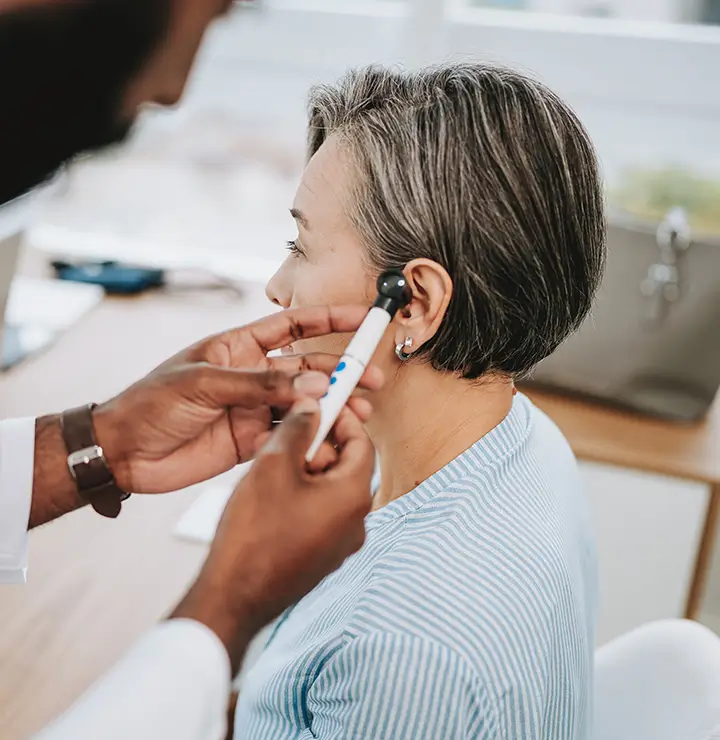Bone-Anchored Hearing Aid
A bone-anchored hearing aid (BAHA) is an implantable hearing device used to treat hearing loss. The device works by directly stimulating the inner ear through the bone.
BAHA has been in use since 1977 in Europe. It has been used in the United States since 1996 for the treatment of conductive, mixed and one-sided deafness. The device is meant for patients who cannot benefit from regular hearing aids.
Patients with chronic ear infections, congenital external auditory canal atresia, a condition in which the ear canal does not develop, or one-sided deafness can benefit from BAHA.
How it works
The BAHA consists of three parts:
- A titanium screw, which is implanted into the skull
- An external abutment, the cone-shaped part that connects with the screw
- The sound processor (hearing device) that clips onto the abutment
The system works by taking the sound from the outside and transmitting it to the inner ear through the bone. This bypasses the ear canal and the middle ear.
The titanium implant is placed during a minor surgical procedure and over time integrates with the bone behind the ear. The hearing device transmits sound vibrations through the titanium implant to the skull and the inner ear where the hearing takes place.
Conditions it treats
Chronic ear infection
People with chronic infections of the outer ear (ear canal) and the middle ear (area behind the ear drum) can benefit from BAHA.
Generally, people with these conditions have a chronic unpleasant drainage from their ears. The infection responds to conventional therapy with medications and surgery most of the time.
However, sometimes it may recur and is deemed non-threatening. In these cases or when the infection recurs with the use of regular hearing aids that are placed in the ear canal, the BAHA is a suitable choice for hearing improvement.
Hearing aids that are placed in the ear canal may aggravate the infection by plugging the ear canal and contribute to increased humidity, which can allow bacteria to grow and cause infections.
The advantage of the BAHA sound processor is that it transmits the sound directly to the hearing organ without going through the ear canal and middle ear.
Therefore, there is no occlusion of the ear canal that can aggravate infections. The BAHA sound processor does not cause the occlusion effect, feedback and whistling seen with conventional hearing aids that are placed in the ear canal.
Congenital hearing loss
Congenital hearing losses caused by abnormalities or malformations of the ear canal or the middle ear can be treated with a BAHA.
Some of these patients do not have an ear canal or an ear canal that did not develop fully. A subset of these patients can be helped with reconstruction of the ear canal and the middle ear.
The BAHA sound processor is directly in contact with the bone of the skull through the titanium attachment allowing direct bone conduction (BC), the sound quality is significantly better than the bone conduction hearing aid, which was used in the past.
There is no pressure on the skin with the use of the BAHA which prevents the pain and headaches caused by the bone conduction hearing aid.
Finally, the BAHA can easily hide under the hair for a better cosmetic result.
One-sided deafness
Having two hearing ears has three main advantages:
1) People with two hearing ears can understand speech better, especially in noisy situations, such as social events, than those with one-sided hearing;
2) People with two hearing ears can sit at a table and hear people on both sides without the need for turning the head;
3) People with two hearing ears can tell the direction from which sound is coming
The BAHA device is an excellent, cosmetically appealing solution to this problem. Traditionally, patients would need to use two hearing aids, one on the deaf side to pick up the signal and another hearing aid in the hearing ear (to take the sound from the other ear and place it in the hearing ear).
This type of hearing aid is called a CROS hearing aid. This means the patient needs to wear two large hearing aids which can be aesthetically displeasing.
When the BAHA is placed on the deaf side, it picks up the sound and transmits it through the bone of the skull (bone conduction) to the inner ear on the hearing side. The normal ear hears sound through air conduction (sound traveling through the air in the ear canal and vibrating the ear drum).
One-sided deafness patients with a BAHA device can hear people sitting on their deaf side without the need to turn their head for listening. Recent studies have shown that patients prefer the sound and speech clarity achieved with the BAHA when compared to the CROS and the unaided condition.
Who can use it?
The BAHA is used for those with:
- Conductive and mixed loss hearing loss with chronic infections of the ear canal or the middle ear (area behind the ear drum)
- A very narrow ear canal
- No ear canal, due to a congenital ear malformation
- Deafness in one ear
Insertion procedure
The BAHA is implanted during a 60-minute outpatient procedure.
For adults, it can be done under local anesthesia. For children, the procedure is done under general anesthesia.
After the titanium attachment is inserted into the skull, the patient must wait three to six months for the metal to integrate into the bone. Once this happens, the sound processor can be placed.
The surgery is easily reversible. Since the BAHA sound processor produces such great quality sound, it is very rare for patients to want the procedure reversed.
There are several different BAHA devices available. To find out which one might be best for you, contact our specialists at 714-456-7017 for a consultation or request an appointment online.








